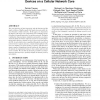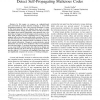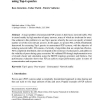240 search results - page 6 / 48 » Malicious Users in Unstructured Networks |
CCS
2009
ACM
14 years 2 months ago
2009
ACM
The vast expansion of interconnectivity with the Internet and the rapid evolution of highly-capable but largely insecure mobile devices threatens cellular networks. In this paper,...
ICC
2007
IEEE
14 years 1 months ago
2007
IEEE
— In this paper, we propose an endpoint-based joint network-host anomaly detection technique to detect selfpropagating malicious codes. Our proposed technique is based on the obs...
INFOCOM
2007
IEEE
14 years 1 months ago
2007
IEEE
We study the interaction among users of unstructured file sharing applications, who compete for available network resources (link bandwidth or capacity) by opening multiple conne...
ACNS
2006
Springer
13 years 11 months ago
2006
Springer
Abstract. We study the impact of malicious synchronization on computer systems that serve customers periodically. Systems supporting automatic periodic updates are common in web se...
DPD
2006
13 years 7 months ago
2006
A major problem of unstructured P2P systems is their heavy network traffic. This is caused mainly by high numbers of query answers, many of which are irrelevant for users. One solu...



